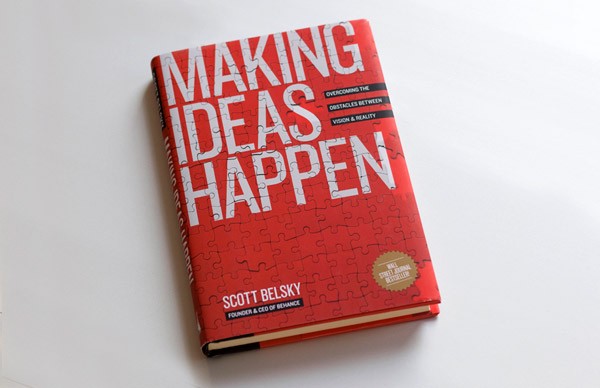By Scott Belsky, Making Ideas Happen. (2010). New York: Penguin. 231 pages.
Reviewed by Diane Byington, Ph.D.
This book might be for you if:
- You have lots of ideas but have trouble getting them to actually happen
- You tend to be disorganized and need help organizing your projects
- You are excited and full of energy at the beginning of a project but get bored and distracted as time goes by, or you love starting projects but rarely complete them
- Your job is to manage creative professionals
Scott Belsky, CEO and Founder of the online creative network, Behance, has spent his professional life working with creative people and helping them to make their ideas “happen.” His thesis is that great ideas abound, but getting them to completion is extraordinarily difficult and requires a different skill set than what is used to generate the idea. This book presents his ideas for what it takes to actualize an idea.
His formula is: Making ideas happen = (The idea) + Organization and Execution + Forces of Community + Leadership Capability.
The book is highly practical, filled with suggestions and methods that have worked for others. If you’re interested in incorporating research or theory into your leadership efforts, you might be disappointed. The book is almost entirely focused on practical suggestions for getting your ideas out there into the world as products. Belsky’s examples are primarily from the world of business, particularly entrepreneurs. Nearly all of the people he uses as examples are successful men. Aren’t there some women who are successful in the creative world? One would doubt it from reading this book.
But I digress. The book is divided into three sections, based on his formula. He ignores the aspect of creativity — having ideas — because that’s not usually where the problems lie.
Organization and Execution. Belsky’s version of project management is called the Action Method. This chapter will be extremely helpful for people who are disorganized and are willing to follow his suggestions. But it’s easy to get bogged down reading it. The Execution chapter was much more interesting. To move an idea forward, one needs to, among other things: take rapid action, abandon ideas when necessary, minimize unnecessary meetings (I especially liked this one), and release your product to the world even if it isn’t perfect.
Harness the Force of Community. Belsky points out that people who work and work on an idea for years, all alone in their basements, rarely succeed in bringing the idea into the world. Community is necessary. He talks about three groups: the Dreamers, the Doers, and the Incrementalists. Dreamers are always generating new ideas, but they struggle to stay focused, and their follow through is often lacking. They do well to partner with a Doer, whose focus is primarily on execution. Then there are the Incrementalists, who can play both roles. This group may get so involved with a number of projects that they don’t make any one project extraordinary. They work best when paired with either a Dreamer or a Doer. But seldom is anything accomplished alone.
Leadership Capability. Most ideas require a team effort, and somebody has to lead the team. This was my favorite section of the book. Chapters include: the rewards overhaul, the chemistry of the creative team, managing the creative team, and self leadership. Some suggestions for managing the creative team include: share ownership of your ideas, leaders should talk last, use conflict to hone ideas, develop others through the power of appreciation, and listen especially to the people others go to for help.
There are a lot of good suggestions in this book, and I recommend it. Even if you don’t have trouble making your ideas happen, it will give you plenty to think about.
— Diane Byington is a writer and coach who consults with The Booth Company.

